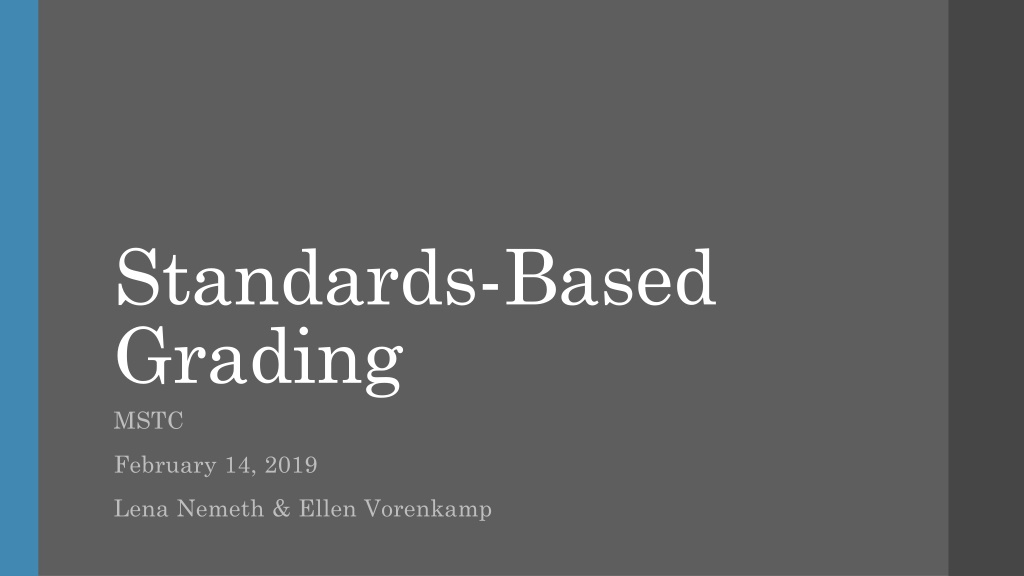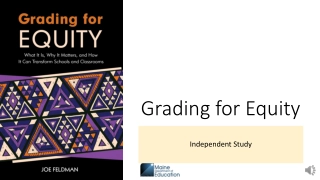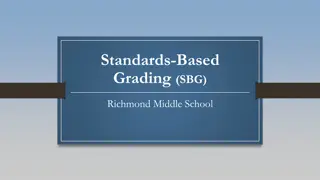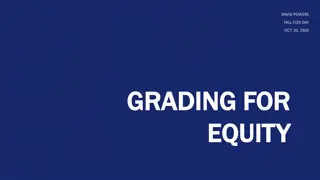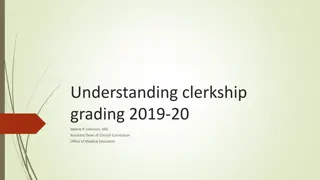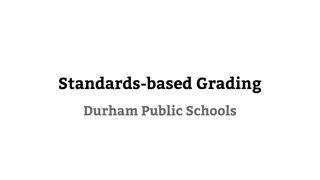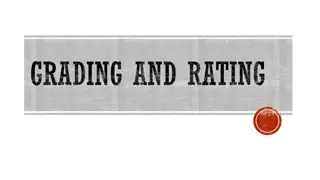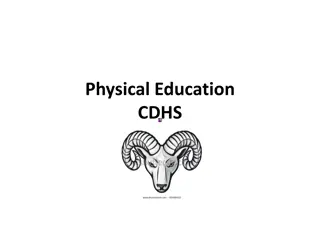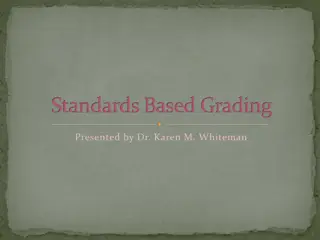Understanding Standards-Based Grading: A Comprehensive Overview
Exploring the evolution and purpose of grading systems, this presentation delves into the history, research findings, and necessity for adopting standards-based grading. Through a series of engaging activities and discussions, stakeholders gain insights into the impact of grading on student learning and motivation.
Download Presentation

Please find below an Image/Link to download the presentation.
The content on the website is provided AS IS for your information and personal use only. It may not be sold, licensed, or shared on other websites without obtaining consent from the author. Download presentation by click this link. If you encounter any issues during the download, it is possible that the publisher has removed the file from their server.
E N D
Presentation Transcript
Standards-Based Grading MSTC February 14, 2019 Lena Nemeth & Ellen Vorenkamp
Community Builder On the Kleen Slate write down your GPA from either high school or undergraduate college experience. Line up according to your GPA highest to lowest Pair up Dialogue around how your grade made you feel good experience? bad experience? Debrief conversations and activity
Agenda Explore purpose of Grading Explore Grading Models Define Standards-Based Grading Define the need for Standards-Based Grading The Learning Journey that Leads to Standards-Based Grading
What is the Purpose of Grading? Brainstorm at your tables If you were to ask the question what is the purpose of grades? to each of these groups of stakeholders what would their responses sound like? Students Teachers Parents
Grading Time Line So how did grading become so convoluted?
History of Grading Letter Grades/ Mastery Grading Focus on Student Learning Percentage Grading c.1910 c.1950 c.1990 c.1970 c.1890 c.1925 Normal Curve Theory Teacher Competence in Grading Grading on Standards Currency pay for work students do Vehicle for Promotion or Retention Public Relations/ Accountability Evaluations of Student Work Motivator Destroyer University/High Ed
What does the research indicate? Looking at Research by Exploring Obstacles to Grading Reform
Reading Protocol Read Text = Makes sense; affirms my thinking ! = aha ; new insight ? = Raises a question, challenges my thinking
Traditional Grading Traditional grading is easy to spot because it typically involves: Simple letter grades. Assessments based on teacher-defined criteria. A single overall grade per student based on a combination of related and unrelated assessments of skills, knowledge, performance and conduct over a period of time. The main advantages of this method are simplicity and professional freedom. However, it results in a very limited measure of a student's abilities. The A on a child's report card might thrill the parents, but this grade obviously doesn't convey any precise information. Blackboard help.com
Traditional Grading 1. Based on assessment methods (quizzes, tests, homework, projects, etc.). One grade/entry is given per assessment. 2. Assessments are based on a percentage system. Criteria for success may be unclear. 3. Use an uncertain mix of assessment, achievement, effort, and behavior to determine the final grade. May use late penalties and extra credit. 4. Everything goes in the grade book regardless of purpose 5. Include every score, regardless of when it was collected. Assessments record the average not the best work. Mark Townsley @ comptencyworks.org
Traditional Grading In a traditional grade book, one usually sees student names listed down the left side of the page and a variety of headings across the top of each page. The titles across the top of the page might include descriptors such as chapter test, homework, pop quiz, class participation, extra credit, unit test, and in some cases, student behavior. The scores or grades for each of these designations may or may not be clearly and precisely linked to the standard which was addressed. In the best case scenario, the teacher using the traditional approach had made sure to connect the assessment instrument to the standards the students were expected to learn, while in the worst case scenario, there may be only a loose or fuzzy link to the standards, connections that are almost accidental rather than deliberate, or no connection at all. Bruce Oliver @ Just Ask Publications
Standards-Based Grading An Overview
What is SBG? Standards-Based Grading is a method of reporting what students have learned and how they demonstrated their learning of the content standards required by the state in which they reside. The U.S. Department of Education includes the following guidelines for standards-based grading: Grades must be related to academic standards and course expectations Public success criteria and student work samples (exemplars) are reference points for grading Grades should be based only on individual academic achievement Grades are based on quality assessments and properly recorded achievement evidence Bruce Oliver @ Just Ask Publications
What is the purpose of standards-based grading? Most states and school districts have published content standards that teachers are expected to teach in their courses or at their grade levels. The purpose of standards-based grading is to align grading practices with the content standards by more accurately measuring and reporting students proficiency in meeting those standards. Bruce Oliver @ Just Ask Publications
Why Standards- Based Grading
Why SBG? Grades should be meaningful and consistent to students, teachers, and families Grades should be objective and not subject to teacher opinions Grades should provide specific feedback to students about their performance and learning opportunities Grades should support learning targets
Turn and Talk How confident are you that the grades students receive in your school/district are: consistent, accurate, meaningful, and supportive of learning?
Why is standards-based grading important and why now? Vital components of the standards-based reform movement are clear measurable course or grade level outcomes and accurate measures to determine where each student stands in relation to the standards. With the adoption and adherence to standards-based learning, it can be easily and readily assumed that all teachers link their planning and lesson implementation to the identified standards. And yet, in some schools, there still remains a disconnect between the teaching of required standards and how student mastery of these standards is determined.
Why is standards-based grading important and why now? Many teachers still follow more established grading practices, and, in fact, there is little clear articulation between the grades students receive and the content standards which are taught. Some have even surmised that our current grading practices lack real meaning as reported achievement data is inconsistent and imprecise. As Robert Marzano has concluded, grades have become almost meaningless.
The Journey to SBG Guaranteed Viable Curriculum Essential Skills/Priority Awareness & Ongoing Communication Research/Rationale Assessment Literacy Professional Learning Standards Learning Progressions Language of the Learning Targets Community Investment Learning Standards Communicating Achievement Quality Evidence Matching Learning Progressions to Levels of Grading Models Reporting Student Progress Quality Grading Practices Using the MISTAR Q Report Card Mastery Alignment of Content and Assessment Quality Assessment Practices Using Evidence to Measure Learning
Community Investment Awareness & Ongoing Communication Research/Rationale Assessment Literacy Professional Learning
Learning Standards Guaranteed Viable Curriculum Essential Skills/Priority Standards Learning Progressions Language of the Learning Targets
Quality Evidence Matching Learning Progressions to Levels of Mastery Alignment of Content and Assessment Quality Assessment Practices Using Evidence to Measure Learning
Communicating Achievement Grading Models Reporting Student Progress Quality Grading Practices Using the MISTAR Q Report Card
